In God's Bedroom
Categories: History | Space | Technology
By Pictolic https://pictolic.com/article/in-god39s-bedroom.htmlYou can not go into the bedroom to God, Even if he is not there. You can not go into the bedroom to God, There is a big secret behind the door. Underwood
Blogger ralphmirebs says: “Literally recently, on June 2, 2015, the Baikonur Cosmodrome, the cradle of world cosmonautics and the largest domestic space harbor, turned 60 years old. Over the years, many different spacecraft have been tested on its territory, the top of which was the Energia-Buran system. But history chose its own path, and the project died in infancy.
More than two decades ago, the heavy sliding doors of the MZK, an assembly and refueling complex, closed for the last time, cutting off two orbital spacecraft from the alluring starry sky. There is a slight irony in the fact that the birthplace of those who were supposed to surf the cosmic expanses became their tomb and crypt.
(Total 58 photos)
 Source: JJournal/ralphmirebs
Source: JJournal/ralphmirebs

1. The installation and filling complex is perhaps the largest building on the territory of the Baikonur Cosmodrome. It was designed by the Izhevsk Institute "Prikampromproekt". The length of the structure is 132 meters, and the height is 62. The so-called retractable structures are located at the ends - simply huge sliding gates. The largest of them have dimensions of 42 by 36 meters, sufficient for the passage of a "grasshopper" with a bundle of Energia launch vehicles with an orbital ship installed on it.

2. The bearing structures of the MZK are made of special steel and must withstand the pressure of the shock wave that occurred in the event of a possible explosion of a heavy launch vehicle at the nearest launch site.
Four-story annexes adjoin the main building on the sides, which house a variety of equipment for testing, organizing ventilation and power supply.
Since the room in which work with the orbital ship took place was not supposed to contain dust, an increased atmospheric pressure was artificially created in it. All doors leading from the building to the corridors were airtight.

3. Three transverse beam cranes moved under the ceiling, each of which has a lifting capacity of 400 tons. Even higher, they are entangled by a complex system of walkways under the roof itself, which provides access to lighting lamps.

4.

5. Currently, there are two ships inside the MZK, one of which is the second flight copy of the Burya, and the other is the OK-MT technological model for practicing pre-launch operations. But, despite the fact that this is a model, inside and out it looks like a real ship. Both are not in the best condition, and because of this they complement each other.

6.

7. And now let's go down and look around the whole room. Above the second (small) end gate there is a magnificent observation platform.
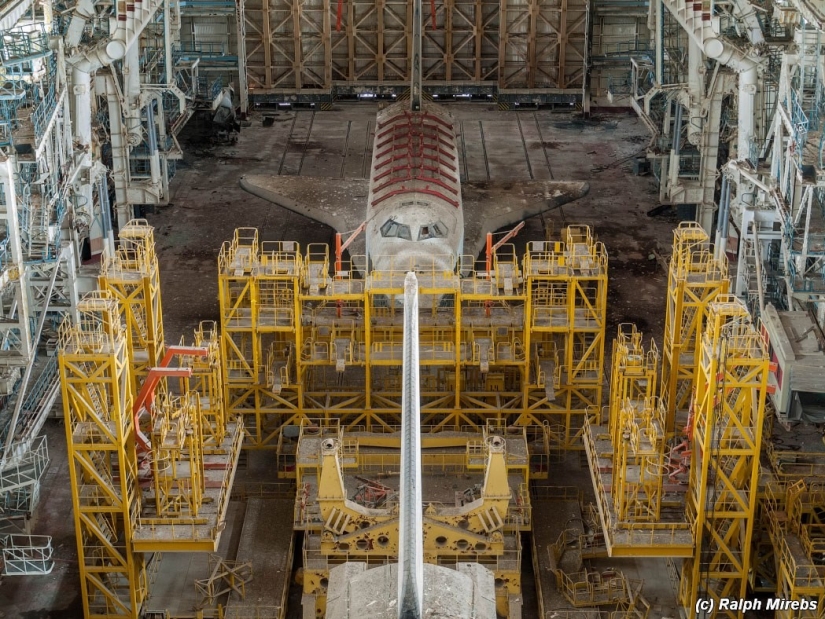
8.
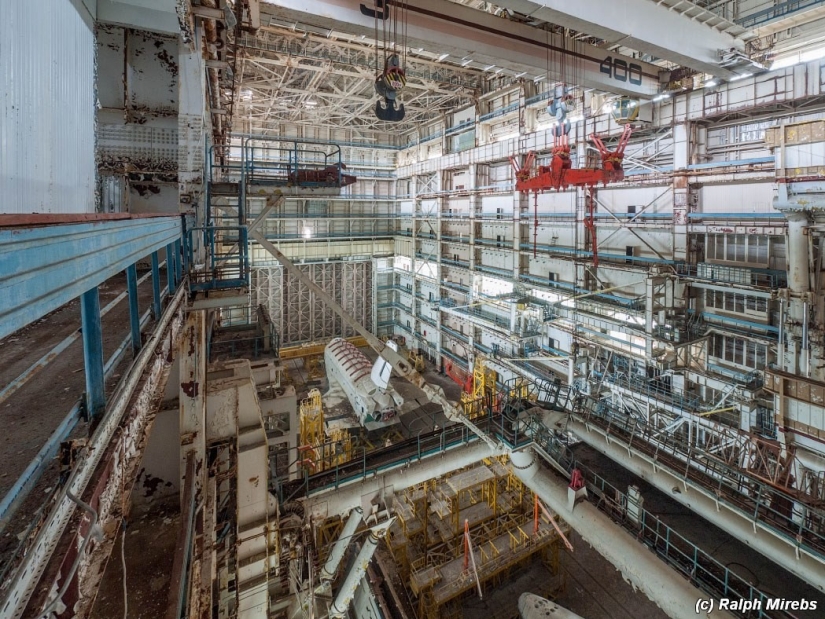
9. The side walls of the MZK are hung with dozens of descending or turning technological platforms equipped with hydraulic drives. These structures are necessary for carrying out all kinds of work at different heights, without touching the heat-shielding plates. Passenger airlocks-ladders for getting on board the orbital ships are also located here.

10.

eleven.

12.
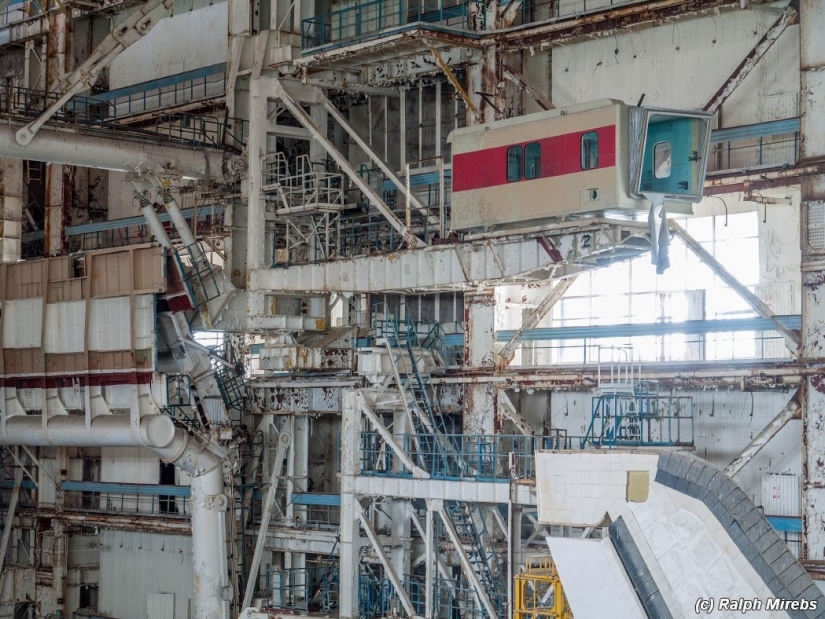
13.
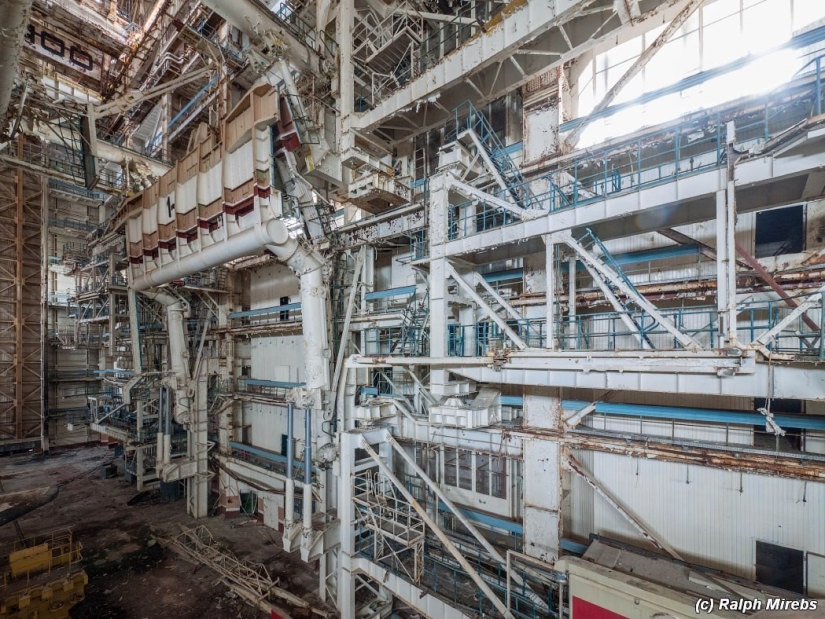
14.

15.

16.

17.

18. I can't resist and allow myself to show two historical photographs demonstrating the use of technology platforms. Photos taken from the Buran website.

19.

20. Let's go down to the orbital ships. They are not mounted on a chassis, but on transport trolleys moving along rails recessed into the floor. In front of the prows of the ships rise other technological platforms designed to access the cockpits and engines. Platforms, like ships, can ride back and forth on rails.

21.

22.

23.

24.

25.

26.

27. Time and people did not spare the ships, and their current state is very deplorable. Part of the thermal protection tiles fell off, the cockpit glazing was broken, the wings and fuselages were covered with an abundant layer of bird droppings accumulated over more than twenty years.

28.

29.

thirty.

31. At the time of the shutdown of work, the readiness of the Burya reached 95 percent. Outwardly, in addition to the individual pattern of heat-shielding tiles, it differs from OK-MT by the presence of installed orientation engines in the bow.

32.

33.

34. In the tail section of the "Storm" lost a container with brake parachutes, but the propulsion system looks quite intact.

35.

36.

37.

38. In the OK-MT model, the tail section was noticeably better preserved, and the windshield was not damaged.

39.

40.

41.

42.

43.

44.

45.

46. Inside the layout, almost everything is the same as on the "adult" ship. Only some elements are replaced by wooden cubes with the name and mass of the block. Of course, it is no longer clear what happened to the missing equipment - it was not installed or torn out for precious metals. Destruction reigns in the airlock and cockpit, but the payload compartment and the engine compartment are relatively clean.

47.

48.

49.

50.

51.

52.

53.
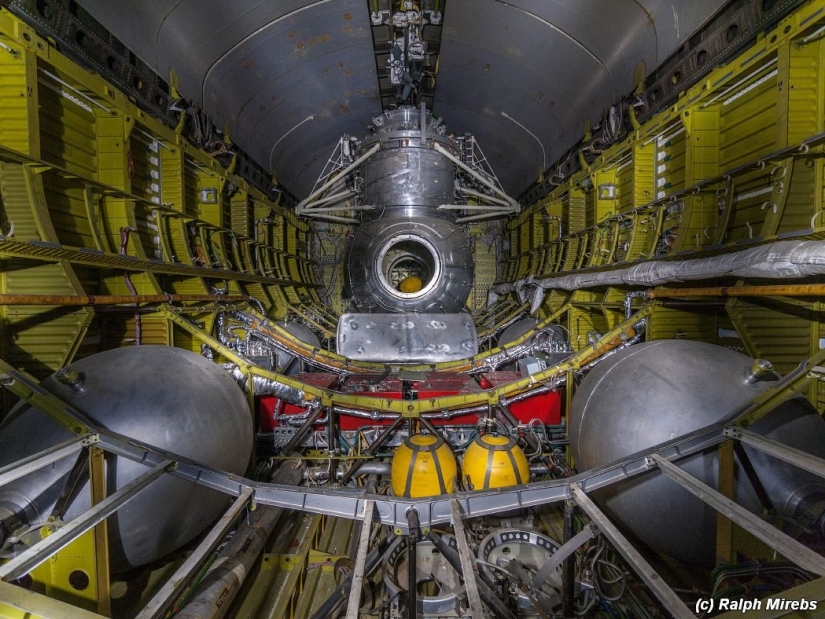
54.

55.

56. A couple more views on the MZK equipment.

57. History moves in a spiral. It is an objective process that repeats over and over again. One can regret the lost time and grieve for the past greatness, but the facts remain above this - Russia is rapidly losing its status as a leading space power. For more than twenty years, the country has not produced anything fundamentally new, continuing to exploit the legacy of the Soviet Union. Only work is underway to modernize the old backlogs, but everything else remains just words and projects on paper. Undoubtedly, a noble past will allow us to stay afloat for another decade or two as a space cab, but only until Chinese rockets overstep the due limit of their reliability and bring down the prices for putting cargo into orbit.
Romance left astronautics, leaving it with only dry figures of financial statistics. Why spend trillions on space if it won't turn a profit in the foreseeable future?
In times of confrontation between political systems, the race of the two superpowers had a beneficial effect on scientific and technological progress. Possible military and ideological use gave rise to dozens of various projects. Yes, most of them did not go beyond the blueprints and layouts, but those that seeped through the sieve of tests and commissions received unlimited support.
The future of Soviet reusable orbital spacecraft was not predetermined even before birth. Despite the huge financial unprofitability of such launches, they could hold out for a long time on the world stage, giving vectors to future horizons.
And I want to finish my article with a play on the title and epigraph.

58. Rise my God! From Ashes Rise! Arise, my god! Rise from the ashes!
Keywords: Baikonur | Spaceship | Cosmodrome
Post News ArticleRecent articles

Lonely people wandering in unusual, surreal surroundings, all in black and white—this is the hallmark of Japanese street ...

It turns out that you can make real art out of old denim things, and Ian Berry is one of the most famous artists who own this ...
Related articles

Have you ever wondered if it is possible to make love in intergalactic space? Erotic scenes from sci-fi movies are impressive, but ...

One of the greatest minds of the century, Stephen Hawking, believed that mankind will soon destroy the Earth. In this case, the ...

Writes blogger Maxim Zarubin aka ffisheye: The construction of Baikonur began seven years before the first manned flight into ...

Surprisingly, many quite ordinary things have names that are unusual to our ears, but at the same time correct. You've probably ...